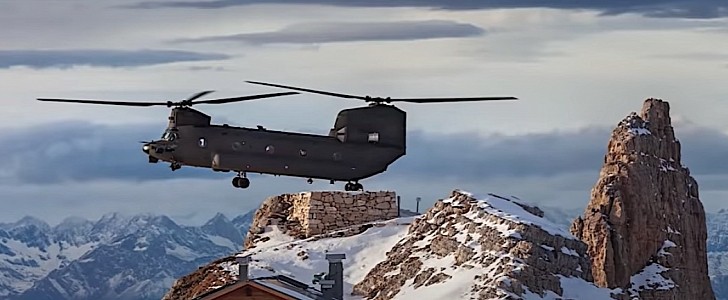Helicopters have been around since before the Second World War when Igor Sikorsky took his VS-300 in the skies over Connecticut. Decades of evolution have made these machines incredibly reliable and advanced. Still, there are two of them that will always be more awesome than others: the Boeing H-47 Chinook and the Bell Boeing V-22 Osprey.
But it's the Chinook we’re here to talk about, not the Osprey, because of the American company’s decision last week to release a video showing why this particular helicopter is unique. The clip is short, just one and a half minutes long, but it’s impressive.
The Chinook is an old machine, even by helicopter standards, but that doesn’t make it less versatile. It was introduced in 1962 as one of few tandem rotor heavy-lift machines and quickly became a favorite of the U.S. military and other organizations in need of heavy lifting and fixed-point hovering.
The fact that this machine is a tandem rotor means it lacks a tail rotor, so it can perform something most its siblings can only dream of: pinnacle landings. That would be a maneuver that allows the helicopter's rear end to be lowered on limited-area surfaces, like say rooftops or cliffs, while the front of the helicopter is still in the air.
Then comes the loading capability of the Chinook. The machine has a lot of room inside and three exterior hooks that help it carry externally a wide variety of loads, including guns and military vehicles. According to Boeing, the Chinook can lift up to 28,000 lbs (12.7 metric tons) of cargo, “including thousands of gallons of water” to fight fires.
Boeing released the video celebrating the Chinook shortly after Honeywell Aerospace was chosen to keep supplying new and spare T55 engines for the helicopter until 2024. That’s the powerplant that currently powers the model, capable of developing 4,800 shaft horsepower and allowing the aircraft to reach speeds of 196 mph (315 kph).
The Chinook is an old machine, even by helicopter standards, but that doesn’t make it less versatile. It was introduced in 1962 as one of few tandem rotor heavy-lift machines and quickly became a favorite of the U.S. military and other organizations in need of heavy lifting and fixed-point hovering.
The fact that this machine is a tandem rotor means it lacks a tail rotor, so it can perform something most its siblings can only dream of: pinnacle landings. That would be a maneuver that allows the helicopter's rear end to be lowered on limited-area surfaces, like say rooftops or cliffs, while the front of the helicopter is still in the air.
Then comes the loading capability of the Chinook. The machine has a lot of room inside and three exterior hooks that help it carry externally a wide variety of loads, including guns and military vehicles. According to Boeing, the Chinook can lift up to 28,000 lbs (12.7 metric tons) of cargo, “including thousands of gallons of water” to fight fires.
Boeing released the video celebrating the Chinook shortly after Honeywell Aerospace was chosen to keep supplying new and spare T55 engines for the helicopter until 2024. That’s the powerplant that currently powers the model, capable of developing 4,800 shaft horsepower and allowing the aircraft to reach speeds of 196 mph (315 kph).









